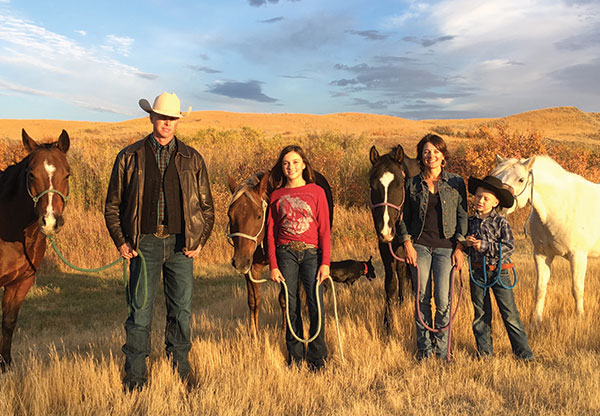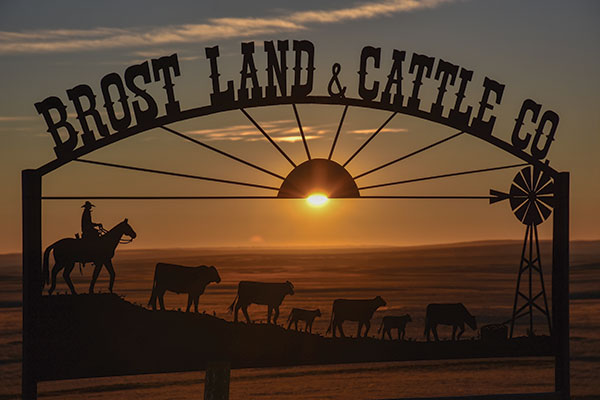Ranchers and Calving Time
I contacted a few select ranchers to speak to them about calving, and to ask; what do they do on their place to make this exciting part of the year go as smoothly as possible? Every ranch is different and while no one can tell another person how to ranch, they can say what works for them. From calving times to moving newborns, this is a fascinating compilation of hard-earned experience, and I extend my thanks to the ranchers that shared their know-how of what works on their place.

Independence — Blade Young
“As we built our outfit up, our cattle herd has always exceeded our facilities, so our cows had to become independent and develop their natural instincts for being good mothers and calving unassisted.”
On our outfit, calving season isn’t even a season anymore, and by that I mean our cattle aren’t checked any more often than they are at any other time of year. One of the reasons is because of labour shortage, it’s difficult to attract workers to this area, and the other reason is our climate. We simply have never had facilities to battle the weather during calving. Because of this, our herd has evolved into superior mothers and are better left alone when calving. They calve unassisted, they mother unassisted, they clean unassisted, we don’t milk any tits, they calve 100 per cent on their own. If you’re riding along and come across a new calf or a cow that’s calving, you just keep riding because the cow is doing what she’s supposed to do.
We breed our heifers to a smaller bull — a black Angus/Longhorn cross — and keep them closer to home so we can keep a little closer eye on them, but they seem to be carrying on their mother’s instinct as last year we calved a couple of hundred head of them and never had to help one. Keep in mind these heifers are generic daughters of cows that have always calved on their own.
If we have a twin or an orphaned calf we don’t graft calves onto cows anymore. The reason why is because our cattle are used to seeing us in trucks or on horseback, and the only time they’ve seen a person on foot it usually involved inoculations, so you can imagine the wreck trying to bring one range cow into the barn on foot. So we just bring the calf home and Irene raises him. Irene is our milk cow — she doesn’t kick and she doesn’t hunt us — and she raised five calves last year.
Our biggest threat is weather and this is why we’ve gone to a later calving time. We move the cows to a stock piled spring grass pasture in late April or early May and if there’s still snow on the ground we’ll take over a liner load of hay – but the best supplement in the world for cows calving is fresh spring grass.
Predation isn’t too much of a problem; one year we had 14 confirmed predator kills so we are much more proactive on predator management now, but compare that to a late snow storm that can kill 60 calves and the possible health issues that would follow weeks after, it’s not much of a problem. We are more than happy with our calving numbers and could never go back to fighting Mother Nature in this climate. Calve on grass and allow their natural instinct to flourish — that’s what works for us.”
» The Young’s sell their calves on T.E.A.M. in big lots for fall delivery and their open cows and heifers in the fall. They cull open cows in July after calving and cull open cows again in November after preg testing.
Young’s Land & Cattle
- Becky, Blade, Davis, Josie and Grady Young
- Tyvan, Sask.
- Commercial herd
- Elevation: 607 m (1,990 ft)
- Average annual precipitation: 12 inches
- Target calving time: first part of May

High Altitude — Jess Parsonage
“We treat our heifers differently than our mature cows who we already know are all good mothers.”
With our heifers, we inoculate them for scours (Scourguard) when we preg check in early October. Then we also give them another booster shot around the end of February. Towards the end of March, we’ll bring the heifers in closer to a small field and then sort off about 40 at a time and move them into the well-bedded calving pen behind the barn. They have free-choice hay and loose mineral supplements to keep them in top shape.”
Because the pen is so close I can just look over the fence to check them, and if a heifer has calved in the morning, they are mothered up and everything’s fine, we tag the calf with a matching ear tag and move them out of the calving pen, down a short alleyway and into a small field — it’s only about a quarter-section. This gives the heifers room to spread out and eliminates a lot of calf mix-ups.
With our cows, as calving time nears we bring the cows down to a pasture that’s about a 1,000 feet lower; it’s a little warmer and a lot less wind. We don’t inoculate the cows for scours as they aren’t in close quarters; they calve out in a big field. After they calve they get moved to a two-section pasture. We also don’t put ear tags on their calves — there’s no need to as they’re all proven mothers.
There’s lots of shelter in these fields I’m talking about — lots of deep coulees, brush and trees so they can get out of the wind. But with both the cows and heifers we calve out later to avoid the deep cold and snow which can kill a newborn calf pretty fast.
This is going to sound funny coming from a horse breeder and trainer, but one thing I’ve learned is that it’s easier to move a brand-new calf with a quad than it is with a horse. A quad scares them and they’ll spook away from it, but a horse doesn’t frighten them so they’re just as liable to run under its belly, and that can lend some excitement when you’re on a colt. But other than the first move when they’re only a few hours old, we do all our cattle work on horseback.
But for this year we did something new: we synchronised the heifers for AI so they might all be calving on the same day.”
» The Parsonages of the Little Big Ranch breed and cull for ease of calving, high, tight bags and good mothering instincts. They sell open heifers in the spring and bred heifers in the fall.
Little Big Ranch
- Jess, Tanya, Olivia and Houston Parsonage
- Maple Creek, Sask. (Cypress Hills)
- Black Angus herd
- Elevation: 1,067 m (3,500 ft)
- Average annual precipitation: 20 inches
- Target calving time: end of April

The Long Walk — Blaine Brost
“Right now (December) our purebred Herefords are out on swath grazing and our commercial herd are out on sorghum. We’ll bring the purebreds home about the middle of January and start feeding them green feed and hay. We hand-feed all of our bulls.”
The purebreds have about a half to three-quarter mile walk to water, so as they come in I’ll start sorting off cows that I know are early calvers and the heifers and bring them down to the yard so I can keep an eye on them. The rest of the purebreds stay out in the pasture. One thing about that long walk to water — it keeps them fit and that sure helps with calving.
We’ve got a trap field (a smaller space so they can check during the night) so when we get started calving if it gets really cold — under -12 C or less — I can bring a cold calf into the barn and warm it up. I use a calf sled that I pull with a 50-foot rope behind my side-by-side. That long rope keeps the sled far enough back from the machine so the majority of the cows will follow their calf with no problem.
All of our cows calve outside and I prefer that because it seems like as soon as you start bringing cows into a barn they take forever to calve.
A few years ago I put up calving cameras in the corral for the early calvers and the heifers; I can check on them periodically through the night without disturbing them and keep an eye on things. With the rest of the herd, if it’s cold I can drive through in my heated truck and check them but otherwise I’ll use the side-by-side. We’ve got a 12′ x 24′ calving shed in the top field that I can put pairs in, but if it’s too cold then I’ll bring the pair down and warm them up in the barn.
With the commercial herd we move them to their calving field about March 25. They start calving in April. Hopefully the weather is nice for them.
Predation isn’t a problem for us at all. We’ve never had an issue with coyotes. We also don’t have an issue with cattle having bad temperaments; our girls can go out and check the herd in the middle of the night and I don’t have to worry.”
» Multi-award-winning Brost Land & Cattle Co. exhibits their purebred Herefords at shows such as Agribition. They will host their annual Hereford sale on the ranch November 30, 2018.
Brost Land & Cattle Co. Ltd.
- Blaine, Shannon, Nicona and Erica Brost / Glenn and Shirley Brost
- Irvine, Alta.
- Purebred Polled and Horned Hereford herd / Commercial herd
- Elevation: 763 m (2,500 feet)
- Average annual precipitation: 10–12 inches
- Target calving time: Purebred Herefords Feb 20 – May 1, Commercial herd April 1 – June 1













